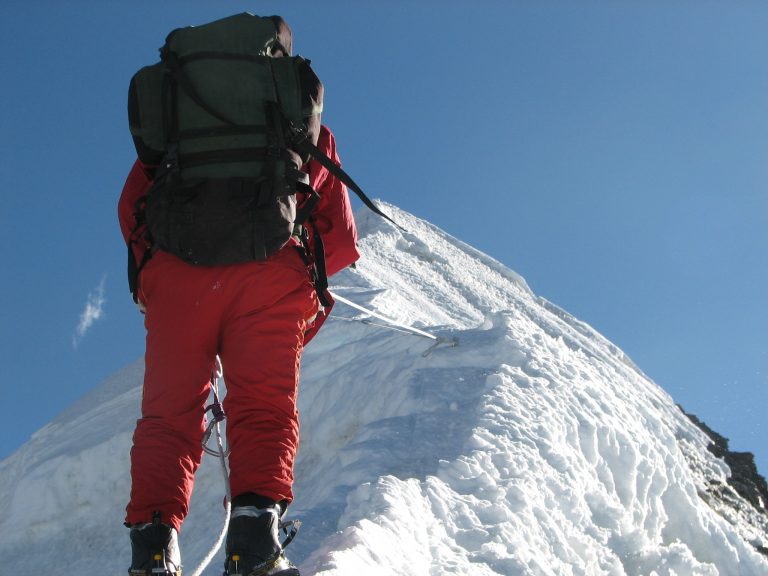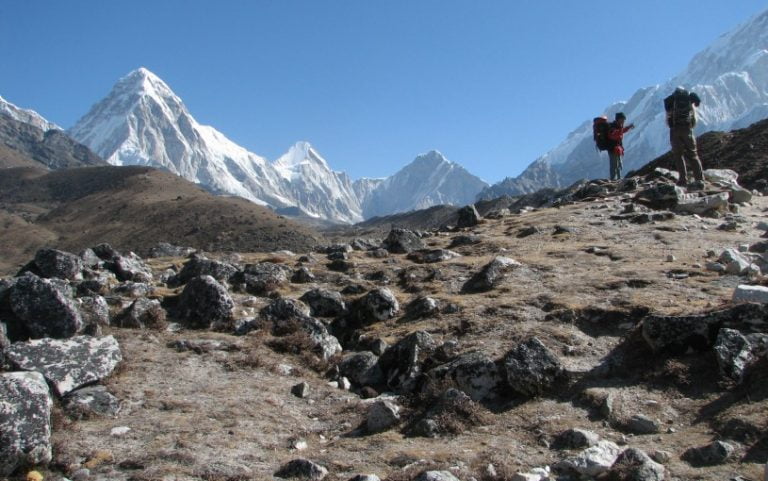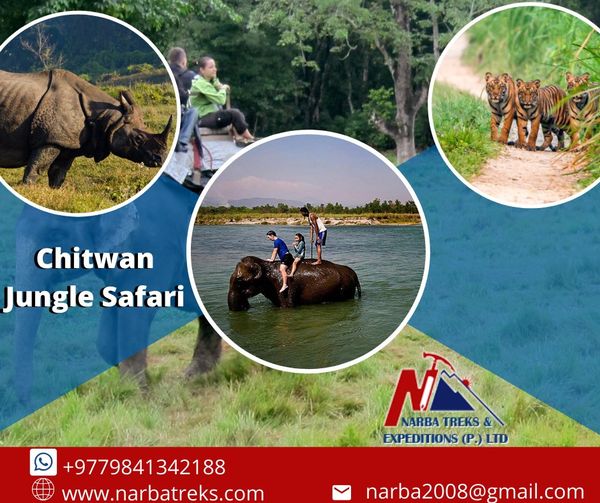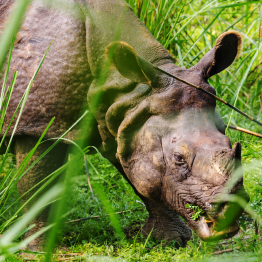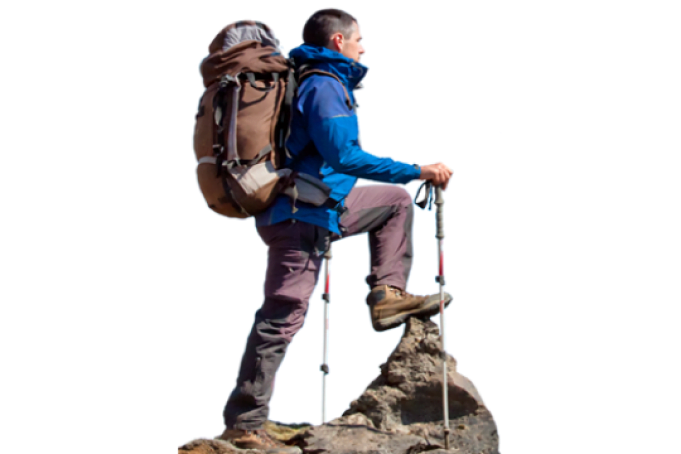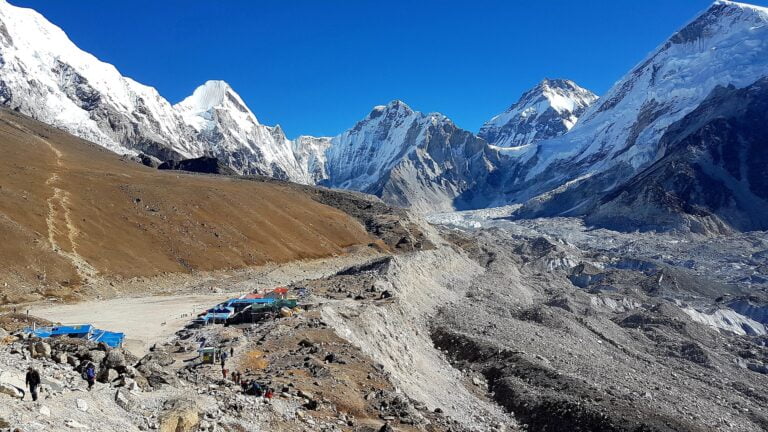
Nepal
Detail
Boarded to the north by the mighty Himalayan Mountains that sweep down to the vast Gangetic Plains of the south is an enigmatic country called Nepal. A small, landlocked country lies between China and India and holds an incredible wealth of diversity, both cultural and natural. Its unique geographical position and the range of elevation produce some of the most incredible Eco-regions in the world, containing an abundance of natural resources. This extraordinary range of elevations is compressed within 200 km north to south, and 800 km east to west, and is divided into three regions: Himal or mountains, the hilly areas, and the Terai.
The Himal region, comprised of the Himalayan Mountains in the north, holds some of the tallest mountains in the world, including the tallest of them all, Mt Everest at 8,848 meters above sea level. The hilly region is the transition from mountains to the Terai of the south, which is a low flat area of mostly grasslands and waterways with smaller hills before reaching into India and the Indo-Gangetic Plain. The ecosystems create a diverse range of flora and fauna housing habitat for some of the rarest wildlife on earth, such as the Snow leopard, Red panda, elephant, and One-horned rhinoceros among many other species.
The country also is home to many ethnic groups, and the Nepalese people are not a homogenous population. However, the harmony within the country is astounding, considering the variety of languages, cultures, and religions residing within the small boundaries. The historical significance of Nepal is also reflected in the myriad of designated UNESCO World Heritage Sites, most of which can be found in the ancient city of Kathmandu and the surrounding valley.
Quick Facts about Nepal
- Capital: Kathmandu
- Official Languages: Nepali (official at the national level)
- Political System: Federal Democratic Republic
- Religions: Hinduism and Buddhism are the two most predominant religions.
- Area: 147,181 km2
- Population: 28,982,771 (2016 estimate)
- Drives on the: Left
- Calling Code: +977
- Time Zone: GMT +5:45
- Working hours: 10 AM to 5 PM
How to Get to Nepal
The only international airport is the Tribhuvan International Airport (TIA) located in Kathmandu Nepal does not lie on any major transit routes. Thus direct flights from Europe or the U.S. are not available, and however, there are direct flights from most major Asian and Middle Eastern countries. During peak travel seasons (October to November), flights can be expensive so that budget travelers may fly into India then overland to Kathmandu (the major tourist hub). This will incur its visa requirements and may end up costing almost the same as a flight into Kathmandu.
- The major airlines that fly into Nepal are as follows, but can regularly change:
- Air Arabia (www.airarabia.com) serves the Gulf States and Russia
- Air Asia (www.airasia.com) Budget flights throughout Asia via Kuala Lumpur
- Air Asia (www.airasia.com) Budget flights throughout Asia via Kuala Lumpur
- Air India (www.airindia.in) serves the subcontinent, including Kolkata and Delhi
- Biman Bangladesh Airlines (www.biman-airlines.com) Daily flights to Dhaka
- Cathay Dragon (www.cathaypacific.com) Four to five flights to Beijing per week
- China Eastern Airlines (en.ceair.com) Serves Lhasa, Kunming, and Shanghai
- Malindo Air (www.malindoair.com) For Kuala Lumpur
- Oman Air (www.omanair.com) For Muscat
- Qatar Airways (www.qatarairways.com) Daily connections through Doha, with
excellent onward flights to the USA and Europe - China Southern Airlines (www.flychinasouthern.com) Serves Guangzhou and Lhasa
- Druk Air (www.drukair.com.bt) Serves Paro daily
- Etihad Airways (www.etihad.com) Daily connections via Abu Dhabi to the rest of the world
- Fly Dubai (www.flydubai.com) several flights per day
- Himalaya Airlines (www.himalaya-airlines.com) reaches the Gulf and Malaysia
- Qatar Airways (www.qatarairways.com) Daily connections through Doha, with excellent onward flights to the USA and Europe
- Thai Airways (www.thaiairways.com) provides the most popular Southeast Asian route to Nepal via Bangkok
Visa Requirements
Visas and permits, luckily, are easily acquired for most incoming travelers. Always check with the official Department of Immigration website at http://www.nepalimmigration.gov.np/page/tourist-visa for the visa obtaining procedure to the citizens of your country. Most can obtain a visa on arrival for up to 90 days. Permits can vary and depends on where you are going. Your trekking company will be able to advise you as to what you need for your trek.
Most travelers may be able to acquire a visa on arrival, and easily cue up at one of the kiosks immigration to enter their information and have their picture taken. There are exceptions, so it is vital to check the Nepal Immigration Website at http://www.nepalimmigration.gov.np/page/tourist-visa for the most up to date information.
- Your passport must be valid for at least six months and have one free page
- SAARC and China nationals require a visa to enter Nepal, but it is free.
- Indian nationals do not need a visa to enter Nepal.
Popular Destinations in Nepal
The popular destinations in Nepal are,
- Kathmandu, Bhaktapur, Patan, and various sites within the cities
- Nagarkot
- Changunarayan temple
- Pokhara
- Chitwan National Park
- Sagarmatha National Park
- Lumbini
- Everest Base Camp
- Upper Mustang
- Annapurna Base Camp
- Langtang National Park
- Rara and Shey Phoksundo Lake
- Upper and Lower Dolpo
- Kanchenjunga Basecamp
- Manaslu Basecamp
Local Currency and Foreign Exchange
The official currency of Nepal is Nepalese Rupee. Although the transactions in major cities like Kathmandu, Pokhara, and Chitwan can be done with credit cards or any other forms of payment cards, paper money is the most common and preferred method of doing so. In remote areas, the new services of payment are not available, and you will have to option to paper money. 1 USD is equivalent to 112 Nepalese Rupee, and you can heat at https://www.nrb.org.np/fxmexchangerate.php for official and reliable information. The authorized bodies in the country provide currency exchange services. There are numerous such stations at Thamel, counters in Tribhuvan International Airport, and banks in various parts of the country to offer hassle-free services to the tourists. You should always be wary while doing so as there can be cases of fraud and trickery when resorting to illegal or unauthorized
entities.
Weather and Climate
The remarkable elevation range has enormous effects on the climate of the country. Nepal experiences weather from cold alpine conditions in the north to incredibly hot temperatures in the south during certain seasons. The Himalayan Mountains to the north block much of the cold winds from Central Asia, and the warm moist air from the Indian Ocean of the summer creates monsoons that sweep up from the south. Nepal has all four seasons: summer, autumn, winter, and spring. Most travelers enjoy visiting during the spring and autumn due to the low rainfall, and generally warm temperatures. These two seasons are also the most favorable for traveling and trekking in the Himalayas as the weather is cold, and the bright skyline allows travelers to relish the views of the mountains and surrounding landscapes.
Festivals
Nepal seems to be in a festive mood for most of the year due to a diverse array of populac residing here. Each ethnic group has its festivals and practices endemic to their culture. And as such, the country is always celebrating a festival or another at any given time. The celebrations also vary according to the geological and political divisions as a region may be pre-dominant of a certain race or culture.
However, the biggest of the festivals celebrated with great zest and zeal are Dashain and Tihar. These festivals, although of Hindu origins, are marked by the majority of the population and bring about great jubilation. Apart from these ‘Big Two,’ Chhath, Lhosar, Buddha Purnima, Eid, Christmas, Udhauli, Ubhauli, and many others are also the significant festivals of the country.
Helpful Hints
- Traveling once you are in Nepal is reasonably priced and can be done by both land and air. Air can be an excellent way to travel longer distances as the road system in Nepal is of poor quality. Bus transport, in general, can be of two varieties, the tourist class buses which are comfortable and usually air-conditioned, and the local microbus which is overcrowded, uncomfortable, and slow.
- The daily budget can be anywhere from the US $50 to the US $150, but of as always, you can spend more or less per day depending on where you at, how you travel, and accommodations.
- Wi-Fi is widely available. You would be hard-pressed to find a hostel or hotel in any village or city without it. Surprisingly even at Everest Base Camp, there is 4G!
The spectacular natural beauty, the precious cultural and historical value, and the incredible mountain scenery all create a truly exceptional and irreplaceable country. Nepal, blessed with culture and traditions of varying populaces, resides in the nation with excellent tolerance and mutual respect. For these reasons, and more is why Nepal consistently rises to the top of must- visit places for world travelers.
Awesome packages we offer

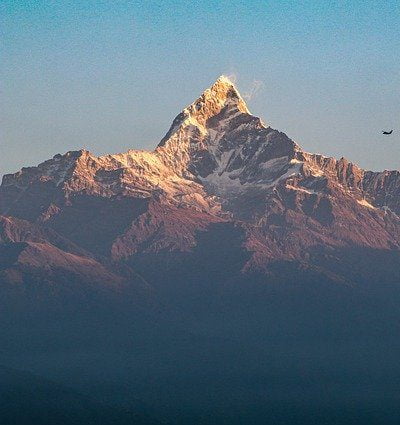
Annapurna Base Camp Trekking
Annapurna Base Camp Trek is an enthralling trek that gives you a unique


